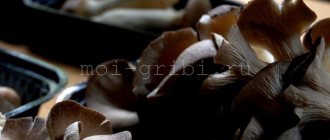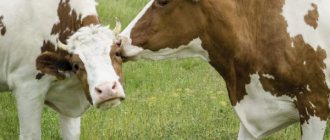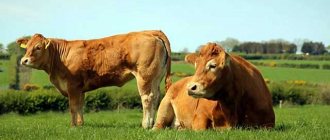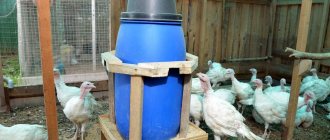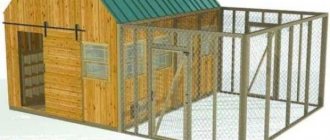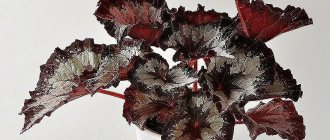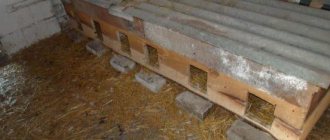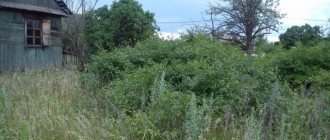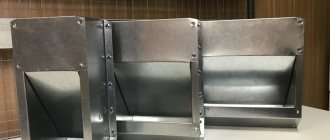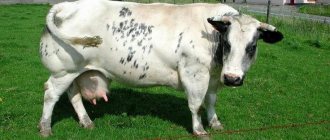Features of building a barn with your own hands
To make a flock for cows convenient and functional, you should make calculations in advance and decide on the livestock that is planned for breeding. This is one of the main points when building a barn with your own hands. The houses should be comfortable for both cows and people.
In addition, before you start building a barn for cows, you need to decide on the choice of materials. These should be simple, budget options, with a long service life. If livestock will be kept indoors during the winter, an effective system of heating, air circulation, lighting and water supply should be provided.
To get a complete barn for raising cows, you need to know what working areas it should consist of. This:
- stall;
- feeding area;
- manure collection area;
- flyer with canopy;
- maternity hospital;
- boiler room;
- cattle pen;
- room for equipment;
- milk storage.
General principles of barn construction
Before starting construction, you will need to take into account some rules, namely:
- the location of the building is chosen taking into account the wind rose;
- the future farm should not be located near residential premises or water sources;
- the material chosen is high-quality, safe, with high thermal insulation;
- the project is drawn up taking into account heating, ventilation and lighting;
- The dimensions of the room must correspond to the needs of the animal; any movements should not cause difficulties.
Did you know? On the skin of the nose of the reproaches there are lines so similar to the pattern of human palms. They are not unique, just like fingerprints, and are never repeated.
Plan with dimensions
When building a barn, certain standards are adhered to for keeping cattle, regardless of whether it will be used for 2 heads or 100. 20 square meters should be allocated for 1 adult cow. m, and for a calf - 10 sq. m. To keep an adult bull you will need 12 square meters. m of free space. To calculate the total area of the premises, you need to multiply these parameters by the number of cows planned for breeding.
The optimal distance between stalls is 1.2-1.5 m. It is better to make the barn height at least 2.5 m. For slurry from manure and urine to drain, the floor slope should be 2-3 degrees.
| Norm for 1 animal | Shed height | |
| 1 adult cow | 10-20 m | 2.5 m |
| Calf | 10 m | 2.5 m |
| Adult bull | 12 sq. m | 2.5 m |
| Numerous livestock | 6 sq. m |
Determining the dimensions of the premises
The optimal size of a barn is considered to be an area of 18 square meters per animal. This area is quite enough for one cow with a calf, storage of feed, and equipment.
If there are several cows on the farm, then the area is calculated according to the norms - 6 or more square meters per individual, and taking into account the offspring - up to 9 meters.
The dimensions should include the feeders in front of the stall, as well as the passage. Make a waste drain on a slight slope. The cesspool is equipped with your own hands outside the barn.
Rules for choosing a shed location
When starting to build a barn for cows at home, you need to wisely choose the area for its placement. Taking into account sanitary requirements, the minimum distance from the barn to residential buildings is 15 m, and to the location of the water source - 20 m. By maintaining such standards, it will be possible to avoid water pollution and an unpleasant constant smell in the house.
See also
How much milk does a cow give on average per day and the number of milking days per year? Read
In addition, it is recommended to provide for the availability of pasture for walking cattle and feeding them. It is better if it is within close reach.
Koshara – sheep shed
Sheep only feel safe when they are in a herd. This means that there is no need to build a separate spacious stall for each animal - the sheep will still crowd together. Sheep spend most of their time outdoors, on the pasture. In the summer, they do not need a barn even for spending the night - a simple fenced enclosure is enough. And for wintering, you can build a sheep shed with your own hands.
Features of keeping a flock of sheep
Sheep are bred primarily for their warm wool. Wool quality is the main indicator of a sheep’s health. When building a shed, you should treat it with an antiseptic to remove fungi and mold. Parasites and rodents are also not allowed in a room with sheep. The hypertrophied herd instinct of sheep does not allow them to scatter around the barn, which is very convenient for the breeder. But still, separate pens should be provided in the barn to separate pregnant or sick animals. Sheep tolerate frosts more easily than other livestock. Thick, warm wool helps them with this. Therefore, when building a sheepfold, you can save on heating and wall insulation. An important condition for keeping a flock of sheep is a hard floor surface. It is harmful for sheep to be on soft bedding, such as hay. This has a negative impact on their weak joints.
What materials can you build from?
Every owner strives to build a barn cheaply and quickly, using available materials. The main thing in the construction of a barn is the use of materials that are safe for animal health; during operation, they should not emit toxic substances.
A good option would be to use wood; planed boards and logs are suitable for these purposes. Considering that the floor in the barn must retain heat and be resistant to aggressive environmental factors, for its installation it is worth using:
- concrete;
- tree;
- clay concrete composition.
The clay covering effectively retains heat in the barn. And concrete floors have a longer service life and are more hygienic. Wood is used more often due to its availability, but it quickly deteriorates and absorbs all odors.
Expert opinion
Zarechny Maxim Valerievich
Agronomist with 12 years of experience. Our best country expert.
Ask a Question
You can build a barn for cows with your own hands from cinder blocks, bricks, and foam concrete. It is important to achieve optimal conditions for livestock; it is necessary to eliminate the presence of drafts and cold indoors.
Construction stages
The process of constructing a structure for housing bulls and cows consists of several stages. Let's look at how to build a barn for bulls step by step.
In any structure, laying the foundation is a top priority. A strong and high-quality foundation for a livestock shed will be the key to the longevity of your future home. There are three ways to build a foundation:
The choice of one or another foundation construction method depends on the type of soil on which the building will stand. The second factor that determines the method of constructing the foundation is the number of cattle that are planned to be populated. After all, the more bulls there are in the barn, the greater the load on the base of the structure will be. An important factor is the material from which you plan to build the barn.
The first method of building a foundation is economical, simple and fast. But it is not designed for heavy loads, therefore, cannot be used to keep a large number of bulls. The columnar method is ideal for sheds built from wood.
A monolithic foundation requires large costs, both financial and labor. Its construction will require special equipment. This foundation for a bull shed is strong and durable.
The most optimal and universal option is the strip method of constructing a foundation.
When laying the foundation for a cattle shed with your own hands, it is important to provide it with high-quality waterproofing. You can use sand or crushed stone as a waterproofing layer.
According to experienced farmers, using wooden flooring is not rational. This floor will not last long. Under the weight of the cattle, the tree will sag, then rot and deteriorate.
How to make durable flooring? The ideal option is to fill it with cement. Such a strong and durable fabric will not absorb unpleasant odors. In addition, the cement floor can support any weight of livestock, regardless of the number of livestock.
The concrete floor is cold. Therefore, it is advisable to install removable wood panels on top of it. If ventilation is necessary, they can be easily removed.
To make cleaning the barn easier, the floors are laid at an angle (inclination angle is about 5%). This is necessary so that animal feces flow to one side.
They can be made of either wood or brick. For a herd of no more than twenty heads, wood is suitable as a building material. If you are planning to acquire a large farm, it is better to use brick for laying walls.
Many people build walls from foam blocks. This is a great alternative to brick. This material is cheaper, and working with it is easy and convenient.
During the construction of walls, it is important to take care of ventilation. Small holes in the walls are located at a height of 2 meters from the floor. With the onset of cold weather, the holes are covered.
The walls are equipped with windows at a height of 1.2 m from the flooring. It is important that the windows open. This way you can always provide your pets with fresh air and good ventilation.
Slate can be used as roofing material. This material has reasonable cost and long service life. If you want to make your bull barn warm enough with your own hands, you need to build the roof in two rows. Make a shed with an attic. It will always be warm in such a room. Plus, the attic can be used to store household equipment.
What to equip
The barn must be equipped with feeders and drinking bowls in a place accessible to the cattle. They are usually installed on the outside of the stall.
You can make a manger for food with your own hands from boards. First, the building material is sanded to eliminate the risk of injury to the bulls. Then they begin directly making the feeders.
The optimal height of the sides is 70 cm. The height of the side towards the stall should be lower than the outer side (about 40 cm). This way the animal can easily get food. The width of the feeder is 40 cm, the distance between the sides at the top is 60 cm.
We arrange the drinking bowl and feeder at a height of 10 cm from the floor. Many farmers use automatic drinkers. Their convenience lies in the fact that livestock always have access to clean and fresh water. The arrangement of the drinking bowl is carried out in a remote place from the feeder.
Organization of the construction process
To get a warm barn for cows, you need to follow a certain algorithm of actions. Each stage requires a responsible approach and the use of quality materials.
Foundation
Regardless of how many cattle you plan to keep, you must make a reliable and durable foundation in the barn. For a small room made of wood, a columnar foundation is quite sufficient. If the barn is designed for a large farm, then a monolithic or strip base will be required.
The main thing here is that the foundation is located at a depth of soil freezing - from 50 to 100 cm or more. Everything will depend on the characteristics of the climate zone. When constructing the foundation, the top layer of earth should be removed and removed.
The barn floor, whether concrete or wood, should slope 5 degrees toward the nearest drain. This technique will force urine and manure into collection containers. To ensure such a slope, the floor level must be 10 cm higher than the ground level.
If the floor is made of concrete, the service life of which is at least 10 years, then wood is used to insulate its surface. But due to the fact that this material absorbs ammonia, it must be replaced at least once every 5 years. When planning drainage ditches, they adhere to a width of 30 cm and a depth of 15 cm. Such parameters make it possible to freely work with a shovel when removing livestock waste.
Walls
Stone walls stand out for their increased strength, but they have one serious drawback - their low ability to retain heat. The best option is to use bricks and foam blocks. But they need additional thermal insulation to maintain a normal indoor microclimate.
See also
Instructions for use of Chiktonik for calves, indications and how to feed cattleRead
In a climate zone where winters are harsh, the barn should be made of warmer materials - adobe brick/shell rock. They are inexpensive and have low thermal conductivity. As for the thickness of the walls, in most cases it is one and a half bricks. When using foam blocks, it is enough to lay them in one row. The height of the room should be 2.5 m.
Roof
According to the recommendations of experienced farmers, it is best to choose slate sheets for roofing. This building material belongs to the category of budget and practical coatings. The roof installation process is relatively simple; you need to:
- Make a frame from planed boards, which are pre-treated with antiseptic compounds.
- Lay thermal insulation on top of the wooden structure.
- Secure the slate sheets using fasteners.
The roof can be either single-pitched or gable. The second option is more preferable; there is also room for hay, and the room is warmer.
Windows and doors
In a barn, the main source of natural light is the windows. According to all standards, their total area must be at least 10% of the entire floor area of the building. As a rule, the lower part of the window opening is located above the floor at a height of 1.5-1.6 m.
There are the following types of windows for a barn:
- hinged type with double glazing;
- hinged, equipped with a polycarbonate insert;
- sliding with sheets of transparent polycarbonate.
It is better to make doors in the barn with a swing plan, which need to be additionally insulated to retain heat inside the room. For convenience, the gate should be made liftable.
Requirements for building materials
To build a barn, various materials are used, taking into account the design, climate and terrain conditions. They must have:
- low thermal conductivity;
- breathability;
- accessibility;
- fire resistance;
- cheapness.
For long-term heated objects, it is permissible to use hollow bricks, concrete-expanded clay slabs, etc. But, since cowsheds are built on the assumption that the natural heat generated by the cattle is sufficient to warm it, the materials must have high heat transfer, and the foundation must have good waterproofing.
When planning a barn, special attention should be paid to the heat transfer of materials
The thickness of the material and its heat transfer are selected taking into account the regional climate. For example:
- lightweight cellular concrete protected with a latex mixture or polyethylene;
- asbestos cement;
- expanded clay concrete;
- aluminum with mineral wool or polystyrene insulation.
A cowshed made of a reinforced concrete frame with asbestos-cement insulation over wooden beams is more efficient and less expensive than a structure made entirely of reinforced concrete slabs. In turn, an asbestos panel with foam plastic is much more economical and warmer than glass brickwork.
Construction of a barn from sandwich panels on a frame
Ceilings are also designed to maintain optimal temperature in the room. The attic is insulated with mineral wool, the roof is constructed from fireproof materials, for example, slate.
It is more convenient to install sliding gates with a thermal curtain in the vestibule; window openings – as small as possible with double glazing and window sills. The absence of internal supports in the barn makes it possible to carry out redevelopment and reconstruction of equipment.
Floor materials
Floors must have heat-protective properties, moisture resistance, resistance to chemical attack, and ease of cleaning and processing. They can be either lattice or solid with a slope (longitudinal 1-2 cm in the passage, transverse 2 cm in the stall) towards the discharge channels.
Important! Wooden floors are the most widespread, but they are not hygienic and imperfect.
Rubber cord covering in a barn
The following types of flooring can be used:
- rubber cord;
- cordo-rubber-bitumen;
- expanded clay-bitumen;
- expanded clay-soil cement.
The presence of bedding is highly desirable
Wooden and foam concrete gratings are the warmest. To prevent injury to the limbs, it is better to make the slats for the slatted floor trapezoidal in shape and position the base upward. They are located perpendicular to the feeding line.
For cows, mixed floors are desirable to ensure the passage of waste products through the grate and the opportunity to rest on a continuous area.
Interior arrangement
In premises where livestock are kept, it is necessary to arrange a feeding area and a rest area. And provide drainage and reservoirs for collecting slurry.
Feeders and drinkers
If there are a lot of heads, then it is more advisable to use automatic feeders. The manual feeding method is more suitable for keeping calves or 1-2 cows. The material for feeders must be safe and non-hazardous. Dimensions 70x40x80 cm. They can hold up to 6 kg of grass. Install feed equipment at a height of 7 cm from the floor.
Water containers can have any configuration, the main thing is that it is convenient for animals to drink from them. Tank volume – from 100 l. It is recommended to place drinking bowls in the far corner of the barn.
Specifics of the premises
Cows are extremely susceptible to external conditions. If the temperature, ventilation system and humidity standards in the room are not observed, their productivity decreases and there is a risk of developing dangerous diseases. To keep cattle, you can make a barn with your own hands, but you need to consider the following points:
Construction always begins with the development of a drawing of a barn. Its detailed study will allow you to think through all the points and foresee the main mistakes. It is recommended to plan the structure in several planes, and also take into account the size of the livestock.
A barn for cows should be built with the prospect of expanding the herd. It is advisable that after placing the animals, you still have several free stalls.
Read also: Choosing a tray for a rabbit and training him to use the toilet
Arrangement of the barn and hygiene of the premises
First of all, you need to provide lighting and fresh air. The optimal temperature for keeping cows is 8–10 C°. Permissible temperature fluctuations are from 4 to 20 C°. The animal must not be allowed to overheat. At a comfortable temperature, metabolic processes in the body do not waste energy on heating the body, thereby increasing the weight gain and milk yield of cows. You also need to organize the correct supply of fresh air. It is not recommended to allow drafts in the room, as they cause many diseases. The ventilation corridor is constructed from boards with a cross-section of 15x15 cm and is brought above the ridge to the roof. It must have a damper that will protect from bad weather and precipitation in the form of snow.
To keep the barn dry and comfortable, you need to provide bedding. It keeps the cow warmer. This material absorbs moisture, thereby making the room drier. If you don't want to clean the shed every day, you can gradually add bedding, which over time will make a kind of pillow. In winter, it will be warmer for the cow to rest on it.
Equipment in the shed includes:
- Feeders for hay, straw and liquid feed. They should be quite voluminous, convenient for feeding and cleaning. The best solution is to install them in front of the stall. Dimensions for one cow: front wall with a cutout for the neck 35–40 cm, back wall 70–80 cm (so that feed does not fall out), length no less than 1.2 meters. Tray for lick (salt). The animal’s body requires replenishment of minerals; in winter, their deficiency is compensated for with salt.
- Drinking bowl. It should be equipped so that the water does not overflow and is not contaminated with waste. Technologies have stepped forward, so automatic drinking bowls are installed in modern barns. They can be connected to the central water supply; if there is no access to it, then to the water tank. The automatic drinking bowl makes your work easier; you don’t need to carry and store water in buckets.
- If there are several cows of different ages in a barn, then a dividing grid is needed so that the animals cannot injure each other.
- Calf pen.
- Door. Many people make a grave mistake when they install several entrances to a room, usually through ones. When opening such doors, a draft is created, which has a detrimental effect on the health of animals. Therefore, we recommend stopping at one entrance to the barn. To further insulate the room, you can make double doors. There will be an air cushion between them that will not let cold air into the barn.
From time to time, the barn needs to be disinfected. Liquid feed and waste are a favorable environment for the development of pathogenic microflora. The walls of the barn should be disinfected with a lime solution twice a year (in spring and autumn). Treat feeders for liquid food with lye. It is also necessary to ventilate the room every day in any weather. Drinkers and service equipment must be cleaned as necessary. We should not forget about blowing out the ventilation ducts. Otherwise, they may become clogged and stop performing their intended function.
In a subsidiary farm, a barn for livestock is an integral part. Everything necessary for keeping cattle is located here - equipment, ventilation, windows. In this case, the structure must be located in the right place. Construction materials also play an important role. Comfortable living will provide the livestock with good health, good weight gain, and high milk yields. The article discusses the rules for building a building with your own hands, taking into account the basic requirements for keeping animals.
How to prepare for building a stall?
First you will need to draw up a construction project and estimate. If the design is competent and correct, structures built with your own hands will last a long time and will practically not require major repairs or alterations.
When thinking about a project, you need to calculate how many heads of cattle will be in the barn. Both existing animals and the approximate future number of bulls and cows should be taken into account. To expand or reduce the premises, additional time and financial resources will be needed; an approximate calculation of the livestock will eliminate unnecessary costs. It is necessary to think about what type of housing for bulls is more convenient: tethered or loose.
The dimensions of the building for bulls are specified in certain standards. One cow or one bull has a barn area of at least 6 meters square. A cow with a calf needs at least 10 square meters of stall space.
When building a shed for steers, you need to calculate the dimensions so that the height of the barn is 2 and a half meters. Bulls and cows do not need more height, because they are short.
Stall equipment
When arranging a pen, it is important to take into account not only the measurements or floor covering, but also the possibility of using certain materials for fencing, which to some extent depends on the way the cows are kept: tethered or free-stalled. Video: Cow barn
Setting up a place for a cow
Video: Barn for a cow. Setting up a place for a cow
When kept in a tether
On a farm with a small number of animals, pens are created mainly from wooden boards and metal pipes, although brickwork is also often used. The main thing to remember is the correct placement of the animal: front to the feeder and back to the gutter. With tethered housing, the stall is constantly used as the main habitat of cattle, which undoubtedly affects its health, productivity and reproductive functions. The norms for the width of the stall in this case depend on the physiological characteristics and size of the cow itself, which most often provides the following values:
- for medium-sized individuals - up to 100 cm;
- for large individuals - up to 120 cm;
- for pregnant cows at 7–9 months of pregnancy - 150 cm.
As a universal option, you can build stalls 120 cm wide, as they are suitable for any animal. Tethered housing is more typical for large farms with a large number of livestock, so multi-row placement of pens would be appropriate, when every two rows are united by a common feed or manure passage.
One such row can accommodate up to 50 stalls, and for breeding bulls and adult sires, a passage with a width of at least 0.6–0.75 m is equipped every two stalls. The stalls are placed so that the animals are either forehead to forehead , or tail to tail.
When loose
Freestall housing of cows in a stall is used mainly for resting cows, and most often they lie here. In this case, the pen is presented in the form of a fenced area, which in size fully corresponds to the parameters of the animals and is suitable according to all criteria for productive slow chewing. For comfortable placement in a lying position, a cow needs a platform of at least 125 cm in width and 280 cm in length, and for stalls located near the wall, this value can be increased to three meters. When making short stalls, the cow's udders and hindquarters will be constantly in the aisle, where they will be easily exposed to dirt and germs.
A good solution for constructing a free-stall pen can be sliding models, the size of which can be adjusted in several ways: by moving the side pipes (the width of the box is adjusted) or by moving the beam for the withers, thereby changing the length of the pen. True, in this case, when organizing a pen using metal pipes, you will need welding skills.
Video: cattle stalls. Stall partitions
Another important point with this option of placing cattle in stalls is properly prepared bedding. Prolonged stay on a concrete base is fraught not only with limb disease, but also with the possible development of bronchial ailments, so a thick bedding of hay or sawdust, changed every day, is simply necessary in this case.
Drawings and diagrams of sheds
A barn is a capital structure, so the drawing is the basic basis for both the calculation of materials and for further construction
When compiling, it is important to take into account, in addition to your wishes, the sizes of blocks, sheets, and measured products, so that during construction there will be as little scraps and waste as possible.
We suggest you read: Plague panleukopenia in cats
The drawing must be drawn up in several projections, preferably all 4 facades, if there are any differences. Indicate the dimensions of the building along the axes, height, opening dimensions, and wall thickness. Indicate the layout of the main structural elements and other technical details. You can use a diagram from the Internet and then work it out in detail.
The layout can be quite simple. If there are rooms for different purposes under one roof, they need to be separated by partitions. It is advisable to arrange at least one window
This is especially important for raising animals, since sunlight has a beneficial effect on their behavior
Lighting and ventilation system
Another important point when building a barn is the installation of a lighting system. In summer there will be no difficulties with lighting. Sunlight will enter the shed through the window openings. You can use wooden or metal-plastic windows during construction. The best option is to install sliding windows for unhindered ventilation in the room. Lighting is required not only for animals, but also for workers caring for livestock and milking heifers.
In winter, there is not enough natural light, which can lead to a decrease in productivity. Lack of lighting leads to a decrease in animal food consumption and assimilation by approximately 10-15%. Which is fraught with deterioration in milk yield. So the arrangement of the lighting system plays an important role.
Thanks to electric lamps, it is possible to extend daylight hours to 14-15 hours, which is required by standards. To equip the barn, you can use conventional incandescent, fluorescent, mercury or halogen lighting fixtures.
In addition, it is important to equip the cattle shed with a ventilation system. If you organize optimal temperature conditions and humidity in the building in combination with the unimpeded removal of harmful elements in the form of gas released from waste products of cows, this will help maintain the immunity of animals at the proper level, regardless of the number of livestock
When building a barn, natural, artificial and mixed ventilation should be equipped. For one animal or two individuals, a couple of ventilation slits are enough to ensure the inflow and outflow of air. For more powerful air exchange, mixed ventilation should be used, which involves air entering through special channels in the wall and exhaust through a fan.
It is not always advisable to install an artificial ventilation system on a small livestock farm, as this requires financial costs. A similar ventilation system is installed on a large farm where the livestock number exceeds 20 individuals.
In the process of constructing a barn, you should take into account the size of the animals, as well as the size of the herd. It is better to use wood for construction
Although in areas with extremely low temperatures, bricks or concrete slabs are most often used for this. Separately, you need to pay attention to feeders, drinking bowls, ventilation, lighting and water supply. Thanks to their well-established work, the productivity of animals increases.
